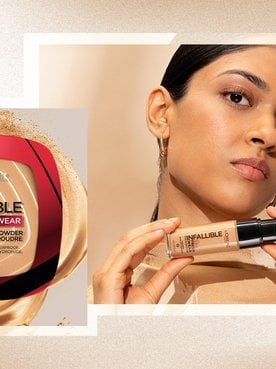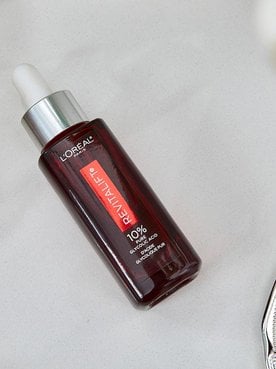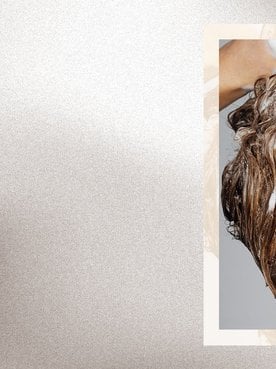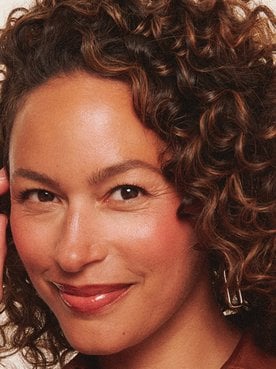If you struggle with uncontrollable frizz or split ends, chances are good you’re dealing with some degree of hair breakage. Knowing how to stop hair breakage can help keep these concerns at bay and restore your mane’s healthy appearance—but it also may require reevaluating your current haircare routine.
For example, you’re probably aware that bleaching your hair can damage your mane. What you may not know is that other, seemingly harmless everyday habits, like brushing your hair or blow-drying without heat protectant, can also contribute to breakage.
Whether you’re looking to prevent hair breakage or need help fixing existing damage, we suggest you keep reading. Ahead, we’ll describe what hair breakage looks like, explain what can cause weak, brittle strands, and share tips on how to prevent hair breakage so you can enjoy strong, healthy-looking strands.
Shop the Products
What Is Hair Breakage?
Hair breakage is exactly what it sounds like—a concern that occurs when a strand of hair snaps or splits due to damage. It’s different from hair shedding, which happens when strands fall out at the root. Breakage often stems from weakened cuticles or disrupted bonds within the hair, both of which can make strands more prone to snapping.
When hair is subjected to excessive tension or stress—like frequent heat styling, chemical treatments, or tight hairstyles—it can become weaker, drier, and more fragile. Without proper care, this stress can lead to breakage anywhere along the strand, from the hairline to the mid-lengths or ends.
If you’re not sure whether you’re dealing with hair breakage or shedding, here’s a quick rundown of the differences:
- Breakage: This occurs when strands snap off due to physical stress, damage, or split ends.
- Shedding: A normal process in which hair strands fall out from the root. People typically shed between 50 and 100 hairs per day, per the American Academy of Dermatology (AAD). More than that is usually considered excessive and should be evaluated by a dermatologist.
- Thinning: A reduction in overall hair density, which can result from increased shedding, slowed growth, or damaged follicles.
What Does Hair Breakage Look Like?
When hair is healthy, the scales on each strand’s cuticle lie flat, which gives the hair a smooth, shiny appearance. Damage, however, can cause these cuticles to lift. Once that happens, the hair becomes drier, weaker, and more susceptible to breakage.
Some common signs of hair breakage include split or thinning ends, excessive frizz, and a rough or uneven texture. You may also notice shorter pieces around the hairline or face-framing sections, since those areas often experience the most mechanical stress from brushing and styling. In severe cases, your ends can appear ragged, choppy, or uneven due to repeated breakage.
What Causes Hair Breakage?
If you want to know how to stop hair breakage, you need to understand why your hair is brittle in the first place. Many things can contribute to breakage, though in most cases, brittleness results from rough handling or an improper haircare routine. Below, we’re diving into some of the most common causes of hair breakage.
1. Heat styling
This may not come as a surprise, but heat styling—including blow drying, flat ironing, and curling your hair—can dry out your strands, especially if you don’t use a heat protectant. Over time, this dryness can cause your hair to become dry and fragile, leaving it susceptible to breakage. To protect your strands, always prep your mane with heat protectant and set your hot tools on the lowest setting possible to achieve your desired look. And when you can, let your hair air-dry and opt for heatless hairstyles, such as overnight beach waves, to avoid heat damage.
2. Overprocessing
Like the rest of your body, your hair needs moisture to stay healthy. Excessive chemical processing—such as keratin treatments, relaxers, and hair coloring—can dry out your strands and leave them looking dull, brittle, and straw-like. This type of damage can also build over time, so the more frequently you color or chemically treat your hair, the more vulnerable it becomes.
If you do regularly color or relax your hair, adjusting your routine is key to keeping it looking and feeling its best. Opt for moisturizing and strengthening products (see our favorites below), and consider spacing out your treatments to help prevent unnecessary dryness and breakage.
3. Bleaching
Whether you’re going platinum or lightening your hair for a brighter color, bleaching can lead to breakage if it’s not done carefully. To remove pigment, bleach lifts the hair’s outer cuticle—an action that can leave strands more vulnerable to snapping. It also pulls moisture from the hair, which can make it feel dry, brittle, and dull.
Bleaching can be especially damaging for those with fine hair or hair that’s already been colored, since these strands tend to be more fragile to begin with. For the best results, it’s always wise to see a professional colorist who can tailor the process to your hair’s needs and use bond-strengthening or hair breakage treatments to help reinforce your strands during and after the service.
4. Over-washing
Washing your hair is essential for keeping your scalp and strands healthy—but just as important is finding the right washing schedule. Most people don’t need to shampoo daily, and doing so can actually strip the hair of its natural oils. That loss of moisture can leave strands drier and, as we’ve established, more prone to breakage.
Overwashing can be especially damaging for natural hair types (like curls and coils), which tend to be naturally drier and rely heavily on those oils for softness, elasticity, and protection. The ideal washing frequency really depends on your hair type, lifestyle, and styling habits.
It’s also worth noting that using clarifying shampoos too often can have similar stripping effects. While they’re great for removing buildup, they’re best used sparingly to avoid unnecessary dryness and fragility.
5. Tight hairstyles
One of the most common causes of breakage along the hairline, temples, or nape is wearing tight hairstyles. Styles that place excessive tension on the hair and scalp (such as sleek ponytails and tight buns) can strain the strands and weaken them over time. There’s also breakage that comes from wearing your hair in the same spot every day. When a ponytail, bun, or clip is repeatedly secured in the same place, pressure and friction can wear down those sections of hair, eventually leading to traction breakage in the areas that take on the most stress.
To help minimize this type of damage, avoid overly tight styles whenever possible. And when you do wear your hair up, choose a silk scrunchie or a soft, snag-free hair tie—they create less tension than traditional tight elastics and are gentler on your strands overall.
6. Aggressive brushing
When brushing your hair, it’s important to be gentle—tugging can create unnecessary tension and cause strands to snap. Hair is also more fragile when it’s wet, so brushing straight out of the shower is especially likely to lead to breakage.
For easier, safer detangling, remove excess moisture from your strands and prep your hair with a detangling spray. Then, use a wide-tooth comb to loosen knots from the ends up. This approach helps remove tangles without subjecting your hair to unnecessary friction or stress.
How Do You Fix Hair Breakage Once It Occurs?
If you’re struggling with weak, fragile hair, chances are you’re hoping to learn how to fix hair breakage and restore your mane’s healthy appearance. The truth is, once hair has snapped, there’s no way to repair it—what’s gone is gone. However, there are plenty of steps you can take to strengthen your strands and help prevent further damage.
Regular trims are essential for removing frayed or split ends before they travel up the shaft. For most people, a trim every eight to 12 weeks is ideal. If you’re growing your hair out, consider asking your stylist for a dusting instead—this technique removes only the very ends, preserving your length while keeping damage in check.
Updating your haircare routine can also make a noticeable difference in both your hair’s appearance and its resilience. Try swapping your usual shampoo and conditioner for a bond-strengthening system, and make sure your strands stay adequately moisturized to help fend off dryness and brittleness. And above all, be gentle: detangle with care, avoid wearing tight hairstyles too often, and scale back on heat styling and chemical treatments until your hair is in better shape.
How Do You Prevent Hair Breakage?
You may not be able to completely prevent hair breakage, but the right routine can help keep your hair resilient and minimize damage. Ahead, find 13 tips to help grow and maintain strong, healthy-looking hair.
1. Limit your wash days
As mentioned above, you may not need to wash your hair daily. Finding the right schedule for your hair type, lifestyle, and habits is important, but so is choosing the right shampoo. To keep your strands feeling soft and healthy, opt for a gentle, hydrating formula like L’Oréal Paris EverPure Sulfate-Free Moisture Shampoo, which is color-safe and suitable for all hair types. Pair it with the coordinating L’Oréal Paris EverPure Sulfate-Free Moisture Conditioner to help detangle, boost shine, and lock in moisture.

2. Avoid scalding showers
Excessively hot water can raise the hair’s cuticles, which increases moisture loss and can leave strands dry, frizzy, and more prone to breakage. It also strips natural oils from both hair and scalp, compounding dryness. If you can, try lowering the water temperature to lukewarm and keep your showers brief whenever possible.
3. Blot your hair dry
After washing your hair, your first instinct might be to rub it with a towel to keep water from dripping everywhere. However, rubbing creates mechanical stress on your strands, which can lead to breakage (especially if you’re using a rough terry cloth towel). Instead, gently blot your hair to remove excess moisture. An old cotton T-shirt works well, or you can opt for a microfiber towel—they’re highly absorbent and extra gentle on brittle, weak strands.
4. Detangle with care
Detangling wet or damp hair requires extra care, since strands are more fragile when wet. Start by applying a detangling spray or leave-in conditioner, such as the L’Oréal Paris EverPure Sulfate-Free Moisture 21-in-1 Leave-In Conditioner, to help reduce friction. Then, using a wide-tooth comb or your fingers, gently work through knots—starting at the ends and gradually moving upward toward the roots. This bottom-up approach helps prevent unnecessary pulling and breakage, making detangling easier and less damaging overall.

Shop the Products
5. Protect hair from heat
As mentioned above, heat styling is a common cause of hair breakage. While opting for heatless hairstyles is the best way to prevent heat-induced damage, it’s not always possible. If you do use heat, prep your strands with a heat protectant to help shield them from high temperatures. We like the L’Oréal Paris EverPure Bond Repair Hair Oil-in-Serum, which protects hair against temperatures up to 450 degrees Fahrenheit. Make sure to apply your heat protectant evenly for all-over coverage.
When styling, use the lowest effective heat setting on your tools and avoid making multiple passes over the same section of hair. Overall, the less heat you use, the better—these small adjustments can make a big difference in preventing breakage and keeping your hair strong.
6. Let your hair air-dry partially
Another way to minimize heat damage is to let your hair air-dry partially before using a blow dryer. Trying to dry soaking-wet hair takes longer, which means your strands are exposed to heat for an extended period. Instead, wait until your hair is about 75% dry before blow-drying. This reduces heat exposure and shortens your drying time—a win-win for healthier hair.
7. Try a different hairstyle
According to the AAD, continuously wearing the same hairstyles—like tight braids or high ponytails—can tug on strands and create tension, leading to breakage. To give your hair a break, wear it down or try low-tension styles such as loose braids or a low, messy bun. Switching up your part regularly can also help limit stress on one area of your hair, reducing the risk of breakage along your hairline, temples, or nape. These small changes let you keep your strands off your face while protecting their strength.
8. Use bond-repairing products
While you can’t repair hair breakage once a strand has snapped, bond-strengthening products can help reinforce your hair and prevent further damage. To protect and strengthen weakened strands, try swapping your regular shampoo and conditioner for a bond-repairing system, such as the L’Oréal Paris EverPure Bond Repair collection. When used consistently, the four-step lineup—which includes a reparative pre-shampoo treatment, gentle shampoo for hair breakage, nourishing conditioner, and a strengthening leave-in—works to rebuild damaged hair bonds from the inside out. This sulfate-free system is suitable for all hair types, including color-treated hair, and daily use can help reduce breakage, strengthen fragile strands, and leave hair smoother and more resilient.

Shop the Products
9. Use a nourishing hair mask
Adding a hydrating mask to your routine can make a noticeable difference if dryness is contributing to brittle, breakage-prone hair. These formulas are designed to replenish moisture (in contrast to bonding treatments, which help repair weak hair bonds). Try using a nourishing formula like the L’Oréal Paris Elvive Total Repair 5 Damage-Erasing Mask once or twice per week to moisturize your hair, reinforce damaged split ends, and restore your mane’s silky, glossy appearance.

To use, wash your hair as usual, then rub the mask between your palms and distribute it evenly through your strands. Leave it on for five minutes, comb your fingers through to ensure full coverage, and rinse thoroughly with lukewarm water.
10. Don’t color too often
We know how frustrating dark roots can be, but coloring your hair too frequently can dry out strands and contribute to hair breakage. To protect your hair, try stretching out the time between appointments so your strands have a chance to recover and strengthen. If you do decide to color, opt for a demi-permanent dye whenever possible—these are gentler than permanent formulas and less damaging than bleach.
11. Sleep on satin (or silk)
If you’re a restless sleeper, consider switching to a satin or silk pillowcase. Tossing and turning on cotton or linen can cause your hair to snag, leading to—yes—breakage. Satin and silk are much smoother, creating less friction and helping protect your strands while you sleep. You can also wear a protective hairstyle, like a loose braid or low bun, to further minimize tangling and stress. If a silk pillowcase feels too pricey, wrapping your hair in a satin or silk bonnet is another effective way to keep your hair safe overnight.
12. Limit how often you brush
Contrary to what you may have been told as a kid, brushing your hair 100 times a day won’t give you shiny, silky strands—it can actually do the opposite. The AAD notes that excessive brushing can create split ends, which leads to breakage, so put that brush down.
If you want smooth, healthy-looking hair, choose the right tool for your hair type and styling needs. Use a wide-tooth comb when your hair is wet to gently detangle, and a brush with soft bristles when your hair is dry to distribute natural oils without causing damage. For an extra-shiny finish, spritz your mane with a lightweight leave-in like the L’Oréal Paris Elvive Glycolic + Gloss High-Shine Leave-In Serum, which makes hair up to 14 times smoother and delivers intense, glass-like shine.

13. Commit to regular trims
Sometimes, the best way to manage hair breakage is simply to cut off damaged ends before they have a chance to worsen. While strengthening treatments can improve brittle hair, they can’t seal split ends or reverse existing damage—only a haircut can. Trimming split ends every eight to 12 weeks helps prevent them from traveling up the hair shaft and causing further breakage. If your ends are particularly damaged or your hair keeps snapping, a fresh cut can give your strands a healthier start. Styles like a pixie cut or blunt bob not only make hair look and feel stronger, but they also simplify your styling routine—a true win-win.
Shop the Products
Next Up: The Best Conditioners for Damaged, Color-Treated Hair
Photo courtesy of L’Oréal Paris







